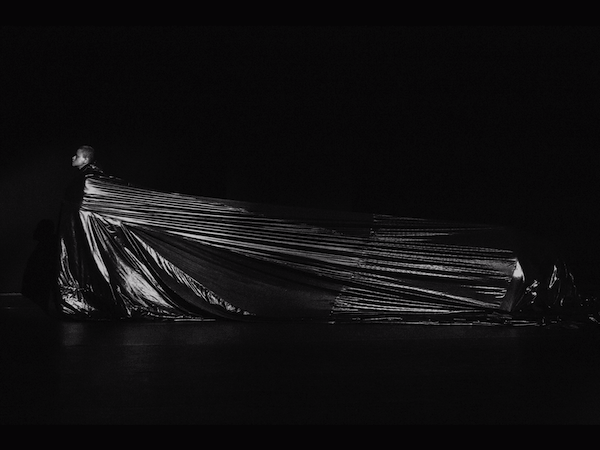Dance Review: Shamel Pitts’s BLACK HOLE — Moving into a Space Beyond Our Own
By Debra Cash
In BLACK HOLE, the TRIBE trio moves as if learning for the first time how their skeletons and muscles are constrained and empowered, perplexed and bedazzled, by gravity’s incontrovertible power.
Shamel Pitts|TRIBE: in BLACK HOLE – Trilogy and Triathlon, presented by the Institute of Contemporary Art, Boston Feb 9-10.

Mirelle Martins in Shamel Pitts’ BLACK HOLE. Photo: Radina Gancheva
Shamel Pitts|TRIBE’s BLACK HOLE is a work of Afrofuturism, but it opens in the primordial past. To synthesized sounds that resemble the urgent hum of a plane accelerating off a runway, a silver torso emerges from a sparkling, bubbling pool, and then another, and another. The silver heads sway, and seem to cast their own light; their movements are not so much synchronized as arising from a common impulse. When the trio begins to crawl, they continue to seem a single organism, whether crab walking or bracing their lengths against one another, knee to knee in a bridging star. When they finally stand, a simple foot slide holds all the drama of a stage-spanning leap.
Shamel Pitts met choreographer Ohad Naharin while he was a dance student at Julliard, and after graduation followed him to Israel. Pitts performed with the Batsheva Dance Company in Tel Aviv for seven years, and on returning the United States began staging Naharin’s work and teaching classes in Naharin’s Gaga technique. In an interview, Pitts described that one source of BLACK HOLE was his commitment to “listen to gravity” and other forces. This is the type of orphic Gaga instruction that usually only makes sense as a spur to studio improvisation. For a change, though, the metaphysical metaphor seems cogent. In BLACK HOLE, the TRIBE trio moves as if learning for the first time how their skeletons and muscles are constrained and empowered, perplexed and bedazzled, by gravity’s incontrovertible power. During every moment of this dark journey of sustained world-making, they move with preternatural deliberation and clarity.
Pitts is fortunate in his collaborators. Both South African–born dancer Tushrik Fredericks (who partnered with Pitts in originating the work) and Ashley Pierre-Louis (performing BLACK HOLE for only the third time during the Boston run) matched Pitts’s intensity, able to shift from being part of the whole to a lonely, existential differentiation. At one point, as Pitts wiped his bald head, Fredericks reached out and thumped his chest, and Pierre-Louis seemed to resist and then succumb to vomiting into her hands, their dismay reminded me of the bronze sorrow locked into the gestures of Rodin’s The Burghers of Calais. The section where Pierre-Louis wraps herself in a billowing cape in a self-possessed processional as a glyph of crown made of light sparks and fades in an upper corner on the backdrop was less compelling, perhaps because it was so literal.
Lucca Del Carlo’s video light and mapping for BLACK HOLE is extraordinary. From the velvety, almost palpable black of the opening moments, through an explosion of petals, a section that transforms a dancer to the ghost of an X-ray, lighting that makes the figures look as if they were drawn in drypoint, and the final tableau that sucks the dancers into a world beyond agency, Del Carlo is the deity that establishes the encompassing environment that takes an audience into a space beyond our own, for exactly one hour, one minute, and one second.
Debra Cash is a founding Contributing Writer to The Arts Fuse and a member of its Board.
